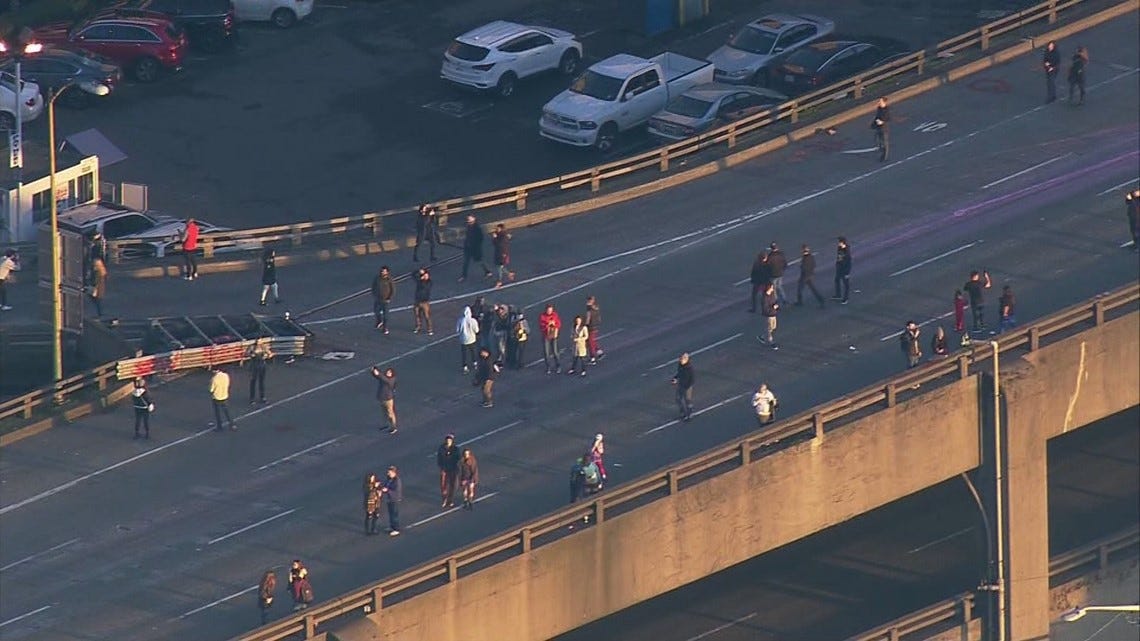Above: People storm the Alaskan Way Viaduct in Seattle, WA as a newly-discovered public space.
Welcome to the future.
Hi and thanks for signing up for my newsletter. If you haven’t already, here’s the not-so-subtle nudge to do so now! 😏
I started this really with one goal: to cut through the hype and deliver zero-emissions content on all things mobility. To name a few, that includes topics like:
autonomous vehicles (“AVs”) (lots of hype);
ride-hailing services (investor hype); and
public transit (not enough hype!).
I don’t intend to limit myself to the above. For example, the supply of affordable housing in cities is equally as (if not more) important as quality transport.
At the same time, there are countless other endogenous [business creation/failure rate] [workforce education levels] [land scarcity] and exogenous [elected officials] [vested interests] factors which contribute to the vitality of our neighborhoods, towns, and cities. I will do my best to incorporate these as well.
Transportation is at the root of every human exchange: economic, informational and social. It’s why I think it deserves its own newsletter.
The thing is.
“We live today in cities and suburbs whose form and character we did not choose. They were imposed upon us, by federal policy, local zoning laws, and the demands of the automobile.”
Here in the US, we live in an extremely car-centric society. Despite younger folks (like myself) continuing to prefer cities over the suburban cul-de-sac, they must contend with antiquated (or non-existent) transport systems. Witness the daily woes of MTA subway riders in NYC. Witness the millions of commuters currently stuck on some snaking freeway in L.A. because “taking the bus” is a bad joke.
Witness still the Seven Kingdoms’ worth of ad spend devoted to influencing a person’s decision to buy/lease a car. Tens of thousands of hours of car commercials have been chiseled into our collective subconscious. People have grown so inured to “driving somewhere” that one’s Nissan Altima or Ford F-150 serves as a sort of phantom limb. Car culture is thus deeply ingrained in the American psyche.
It should be no surprise then that Americans are driving at a greater clip than ever before. Big cities (I’m talking cities like New York, Chicago, LA, Philadelphia, D.C., Atlanta and Houston) across the country are struggling to balance the ability to attract (and retain) a skilled young workforce while simultaneously ensuring that their roads remain passable and their trains and buses run on time.
At the same time, Covid has dramatically upended the work commute as we once knew it (at least for the time being). While some Covid-related mobility trends will disappear as we revert back to the mean, others — like people’s shirking public transportation or sporadic (and increasingly unpredictable) peaks and troughs of daily movements — may unfortunately prove sticky. And not always for the reasons we may suspect.
A brief manifesto.
The success or failure of a city hangs on its ability to accommodate its people’s movements. Not everyone can afford to live in or near the urban core. Today, some of the fastest growing places in the US are where there’s lots of room to “build out” as opposed to building up. Much of this has to do with the economics of housing coupled with statist (and frankly, stupid) land use policies. At the same time, the new WFH paradigm upends agencies’ institutional knowledge about how to run a train, or bus, or for-hire car service. In the absence of viable alternatives, people chasing cheap housing begets ICE-centric 1950s-syle suburban sprawl which begets even more car congestion.
I’m not here to wave the banner to “ban cars” (there’s already a very entertaining podcast on that). Instead, I believe that if America is deadly serious about promoting the general welfare, it needs to first ensure that ALL of its people can physically access jobs, education and their fellow citizens. That will ultimately require a range of transportation modes and systems. Profit-motivated companies will offer up solutions, but they won’t necessarily solve the issues on their own (in some cases, they may make things even worse). City Halls across the country have an equally important role to play, for example by cutting through the thick undergrowth of ossified rules drawn up by dead bureaucrats and where possible enabling innovation to grow the pie for all.



